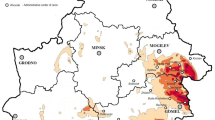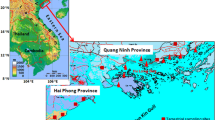Abstract
The East Urals Radioactive Trace (EURT) was formed after a chemical explosion in the radioactive waste-storage facility of the Mayak Production Association in 1957 (Southern Urals, Russia) and resulted in an activity dispersion of 7.4 × 1016 Bq into the atmosphere. Internal exposure due to ingestion of radionuclides with local foodstuffs was the main factor of public exposure at the EURT. The EURT cohort, combining residents of most contaminated settlements, was formed for epidemiological study at the Urals Research Center for Radiation Medicine, Russia (URCRM). For the purpose of improvement of radionuclide intake estimates for cohort members, the following data sets collected in URCRM were used: (1) Total β-activity and radiochemical measurements of 90Sr in local foodstuffs over all of the period of interest (1958–2011; n = 2200), which were used for relative 90Sr intake estimations. (2) 90Sr measurements in human bones and whole body (n = 338); these data were used for average 90Sr intake derivations using an age- and gender-dependent Sr-biokinetic model. Non-strontium radionuclide intakes were evaluated on the basis of 90Sr intake data and the radionuclide composition of contaminated foodstuffs. Validation of radionuclide intakes during the first years after the accident was first carried out using measurements of the feces β-activity of EURT residents (n = 148). The comparison of experimental and reconstructed values of feces β-activity shows good agreement. 90Sr intakes for residents of settlements evacuated 7–14 days after the accident were also obtained from 90Sr measurements in human bone and whole body. The results of radionuclide intake reconstruction will be used to estimate the internal doses for the members of the EURT cohort.




Similar content being viewed by others
References
Akleyev A, Deltour I, Krestinina L, Sokolnikov M, Tsareva Yu, Tolstykh E, Schüz J (2016) Incidence and mortality of solid cancers in people exposed in utero to ionizing radiation: pooled analyses of two cohorts from the Southern Urals, Russia. PLoS One 11(8):e0160372. doi:10.1371/journal.pone.0160372
Annenkov BN, Dibobes IK, Alexakhin RM (eds) (1973) Radiobiology and radioecology of agricultural animals. Moscow, Atomizdat (in Russian)
Avramenko MI, Averin AN, Drozhko EG, Glagolenko YuV, Loboiko BG, Mokrov YuG, Romanov GN, Kotov ES, Filin VP (1997) Accident of 1957 and East Urals Radioactive Trace. Radiat Saf Probl (Mayak Prod Assoc Sci J) 3:18–28 (in Russian)
Bournazyan AI (ed) (1974) The results of studying and the experience of the liquidation of consequences of accidental contamination of territories by uranium fission products. Moscow, Ministry of Health of USSR (in Russian)
Degteva MO, Vorobiova MI, Tolstykh EI, Shagina NB, Shishkina EA, Anspaugh LR, Napier BA, Bougrov NG, Shved VA, Tokareva EE (2006) Development of an improved dose reconstruction system for the Techa River population affected by the operation of the Mayak Production Association. Radiat Res 166:255–270
Degteva MO, Shagina NB, Tolstykh El, Vorobiova MI, Anspaugh LR, Napier BA (2009) Individual dose calculations with the use of the revised Techa River Dosimetry System TRDS-2009d: Final report for milestone 22. Chelyabinsk and Salt Lake City, Urals Research Center for Radiation Medicine and University of Utah
Degteva MO, Shagina NB, Vorobiova MI, Anspaugh LR, Napier BA (2012) Reevaluation of waterborne releases of radioactive materials from the Mayak Production Association into the Techa River in 1949–1951. Health Phys 102(1):25–38
Dibobes IK (1971) Sanitary-hygiene basis and estimate of the efficiency of actions taken on the use of territory contaminated by strontium-90. Doctoral Thesis. Moscow, Institute of Biophysics (in Russian)
Gusev NG, Margulis Yu, Marey A, Tarasenko N, Shtuckenberg Yu (1959) Collection of radiochemical and dosimetric techniques. Moscow, Medgiz (in Russian)
Instructional guidelines (1960) Instructions and guidelines for the sanitary and epidemiological stations in the field of radiation hygiene. Moscow, Medgiz (in Russian)
International Commission on Radiological Protection, Age-dependent Dose to Members of the Public from Intake of Radionuclides: Part 2: Ingestion Dose Coefficients. Publication 67 (1993) Annals of the ICRP, 23 (3/4), Pergamon Press, Oxford
Izrael YA (ed) (2013) Atlas of the East Ural and Karachay radioactive trace including forecast up to 2047—Moscow, IGCE Roshydromet and RAS. http://downloads.igce.ru/publications/Atlas/CD_VURS/about.html. Accessed 4 July 2016
Izrael YA, Artemov EM, Vasilenko VN, Nazarov IN, Nakhutin AI, Uspin AA, Kyamkin AM (2000) Radioactive contamination of Urals region by Mayak Production Association. In: Radioactivity under nuclear explosions and accidents. Proceedings of International Conference, Moscow, 24–26 April, 2000. Gidrometeoizdat, St. Petersburg, pp 411–424 (Russian)
JNREG (1997) Joint Norwegian-Russian Expert Group for Investigation of Radioactive Contamination in the Northern Areas. Sources Contributing to Radioactive Contamination of the Techa River and Areas Surrounding the “Mayak” Production Association, Urals, Russia. Norwegian Radiation Protection Authority, Østerås, Norway
Khokhryakov VV, Drozhko EG, Romanov GN, Mokrov YuG, Kyamkin AM, Volobuev PV, Vorobiova MI, Kostychenko VA, Akleyev AV (2002) Characteristics of anthropogenic radiation impact on territory and population. In: Consequences of an anthropogenic radiation incident and rehabilitation problems of the Urals Region. Comtehprint Publisher, Moscow, pp 8–77 (Russian)
Kostyuchenko VA, Peremyslova LM, Popova IY, Kazachyonok NN, Melnikov VS (2012) Main dependencies in reduction of radiation exposure to the population of the Southern Urals. Health Phys 103(1):42–46
Kozheurov VP (1994) SICH-9.1-a unique whole-body counting system for measuring SR-90 via bremsstrahlung. The main results from a long-term investigation of the Techa River population. Sci Total Environ 142(1–2):37–48
Kozheurov VP, Zalyapin VI, Shagina NB, Tokarevaa EE, Degteva MO, Tolstykh EI, Anspaugh LR, Napier BA (2002) Evaluation of uncertainties in 90Sr-body-burdens obtained by whole-body count: application of Bayes’ rule to derive detection limits by analysis of a posteriori data. Appl Radiat Isot 57(4):525–535
Krestinina L, Preston DL, Davis FG, Epifanova S, Ostroumova E, Ron E, Akleyev A (2010) Leukemia incidence among people exposed to chronic radiation from the contaminated Techa River, 1953–2005. Radiat Environ Biophys 49:195–201
Krestinina LY, Epifanova S, Silkin S, Mikryukova L, Degteva M, Shagina N, Akleyev A (2013) Chronic low-dose exposure in the Techa River Cohort: risk of mortality from circulatory diseases. Radiat Environ Biophys 52(1):47–57
Krestinina LYu, Silkin SS, Epifanova SB (2014) Analysis of solid cancer mortality risk for the population exposed in the territory of East-Urals radioactive trace over a 50-year period. Radiat Hyg. 7(1): 23–29 (in Russian)
Marey AN, Zykova AS (eds) (1980) Guidelines on the sanitary control over the content of radioactive substances in the environment objects. Moscow, Minzdrav USSR (in Russian)
Molchanova I, Mikhailovskaya L, Antonov K, Pozolotina V, Antonova E (2014) Current assessment of integrated content of long-lived radionuclides in soils of the head part of the East Ural Radioactive Trace. J Environ Radioact 138:238–248
Müller H, Gering F, Pröhl G (1999) Model Description of the Terrestrial Food Chain and Dose Module FDMT in RODOS PV4.0. Neuherberg, GSF
Napier BA, Degteva MO, Shagina NB, Anspaugh LR (2013) Uncertainty analysis for the Techa River Dosimetry System. Med Radiol Radiat Saf. 58(1):5–28
Panteleev LI (1966) Probabilistic—statistical regularities of the strontium-90 distribution in the environmental objects, animals, and humans. Doctoral Thesis. Chelyabinsk, Branch N4 Biophysics Institute (in Russian)
Peremyslova LM, Skryabin AM (2001) Transfer of Sr-90 along food chain. In: Ecological and health effects of the radiation accident of 1957 at the Mayak PA. Medbioextrem, Moscow, pp 93–116 (Russian)
Peremyslova LM, Kostyuchenko VA, Degteva MO, Baturin VA, Popova IYa, Akleyev AV (2001) The usage of current population exposure dose for justification of EURT area rehabilitation. Radiat Saf Probl (Mayak Prod Assoc Sci J) 2:50–54 (in Russian)
Peremyslova LM, Tolstykh EI, Vorobiova MI, Degteva MO, Safronova NG, Shagina NB, Anspaugh LR, Napier BA (2004a) Analytical review of data available for the reconstruction of doses due to residence on the East Ural Radioactive Trace and the territory of windblown contamination from Lake Karachay. Final report for Milestone 10. Chelyabinsk and Salt Lake City, Urals Research Center for Radiation Medicine and University of Utah http://biophys.urcrm.ru/publications/Milestone10.pdf. Accessed 22 July 2016
Peremyslova LM, Akleyev AV, Kostyuchenko VA, Degteva MO, Tolstykh EI (2004b) Dietary intakes and internal exposure doses received by residents of the Karachay Trace. In: Proceedings of 11th international congress of international radiation protection association. International Radiation Protection Association, Madrid. Paper ID 325 http://irpa11.irpa.net/pdfs/7c12.pdf. Accessed 22 July 2016
Romanov GN, Shejn GP, Aksenov GM (1997) Exposure doses for the population living on East-Urals radioactive trace: current estimates. Radiat Saf Probl (Mayak Prod Assoc Sci J) 4:52–67 (in Russian)
Schonfeld SJ, Krestinina LY, Epifanova S, Degteva MO, Akleyev AV, Preston DL (2013) Solid cancer mortality in the techa river cohort (1950–2007). Radiat Res 179(2):183–189
Shagina NB, Tolstykh EI, Degteva MO, Anspaugh LR, Napier BA (2015) Age and gender specific biokinetic model for strontium in humans. J Radiol Prot 35(1):87–127
Skryabin AM (1971) Regularities of 90Sr behavior in food chains and human diet in the condition of global radioactive fallout. Doctoral Thesis. Moscow, First Medical Institute (in Russian)
Skryabin AM, Panteleev LI, Antropova ZG (1973) Radiation-hygienic and radioecological investigation in the areas of Pacific nuclear explosion and Southern Urals regions contaminated with long-living radionuclides. Technical report No. 945. Chelyabinsk, Urals Research Center for Radiation Medicine (in Russian)
Skryabin AM, Safronova NG, Peremyslova LM, Polyakova EA (1985) Hygienic assessment of the consequences of contamination of large territory by radioactive wastes. Technical report No. 1549. Chelyabinsk, Urals Research Center for Radiation Medicine (in Russian)
Ternovsky IA, Romanov GN, Sokhina LP, Fedorov EA, Teverovsky EN, Korsakov Yu, D, Belova EI, Voronov AS, Kozhevnikiva TL, Martyushov VZ, Mishenkov NN, Smirnov EG, Filatova EV, Volkov FS, Melnikov YuI, Antropova ZG, Baturin VA, Lebedev VM, Pitkyanen GB, Safronova NG, Ryabcev IA (1985a) Exposure situation and dynamics of radionuclide behaviour in the environment. Technical report MIRAGE, Volume 3. Ozyorsk (in Russian)
Ternovsky IA, Romanov GN, Fedorov EA, Shvedov VL, Skryabin AM, Malkin PM, Melnikov YuI (1985b) Radiation protection of the exposed population. In: Study of radioecological, radiation-hygienic and social-economical consequences of massive radioactive contamination of large territories (1958–1984). Technical report MIRAGE, Volume 5. Chelyabinsk (in Russian)
Teverovsky EN, Ternovsky IA (1985) Permitted levels of radioactive emissions into the atmosphere. Moscow, Energoatomizdat (in Russian)
Tolstykh EI, Kozheurov VP, Vyushkova OV, Degteva MO (1997) Analysis of strontium metabolism in humans on the basis of the Techa river data. Radiat Environ Biophys 36(1):25–29
Tolstykh EI, Degteva MO, Peremyslova LM, Vorobiova MI, Kozheurov VP (2002) Dietary intake and 90Sr body contents in the residents of the East Urals Radioactive Trace. Forty-year study experience. Int J Radiat Med 3:134
Tolstykh EI, Peremyslova LM, Shagina NB, Degteva MO, Vorobiova MI, Tokareva EE, Safronova NG (2005) The characteristics of 90Sr accumulation and elimination in residents of the Urals region in the period of 1957–1988. Radiat Biol Radioecol. 45(4):464–473 (in Russian)
Acknowledgements
The research was funded by the U.S. Department of Energy’s, Office of International Health Programs; and by Russian Federal Medical-Biological Agency in the framework of joint US-Russia Project 1.1. The authors appreciate very much the invaluable contribution of Dr. G.N. Romanov to investigations of the EURT area. The authors would like to thank Dr. N.B. Shagina for analysis of data on β-activity measurements in human excreta and foodstuffs and V.A. Krivoschapov for technical assistance in the paper preparation.
Author information
Authors and Affiliations
Corresponding author
Rights and permissions
About this article
Cite this article
Tolstykh, E.I., Peremyslova, L.M., Degteva, M.O. et al. Reconstruction of radionuclide intakes for the residents of East Urals Radioactive Trace (1957–2011). Radiat Environ Biophys 56, 27–45 (2017). https://doi.org/10.1007/s00411-016-0677-y
Received:
Accepted:
Published:
Issue Date:
DOI: https://doi.org/10.1007/s00411-016-0677-y




